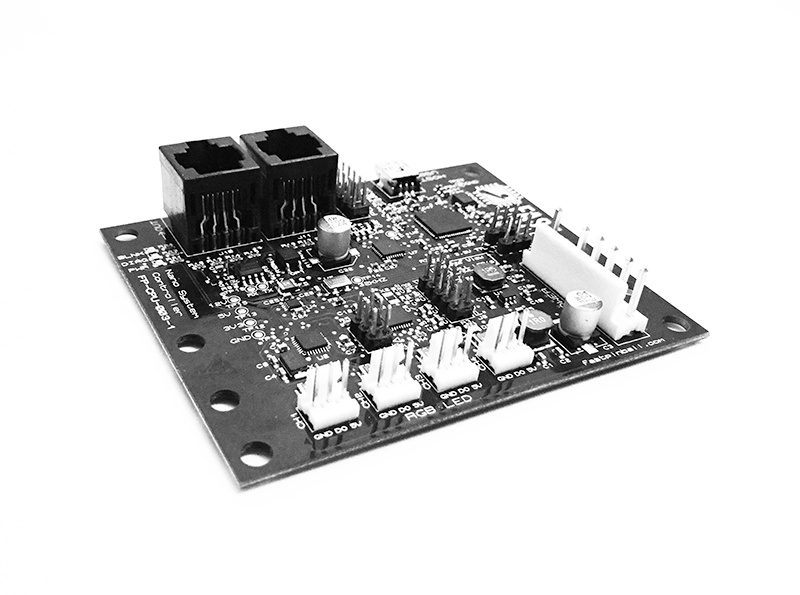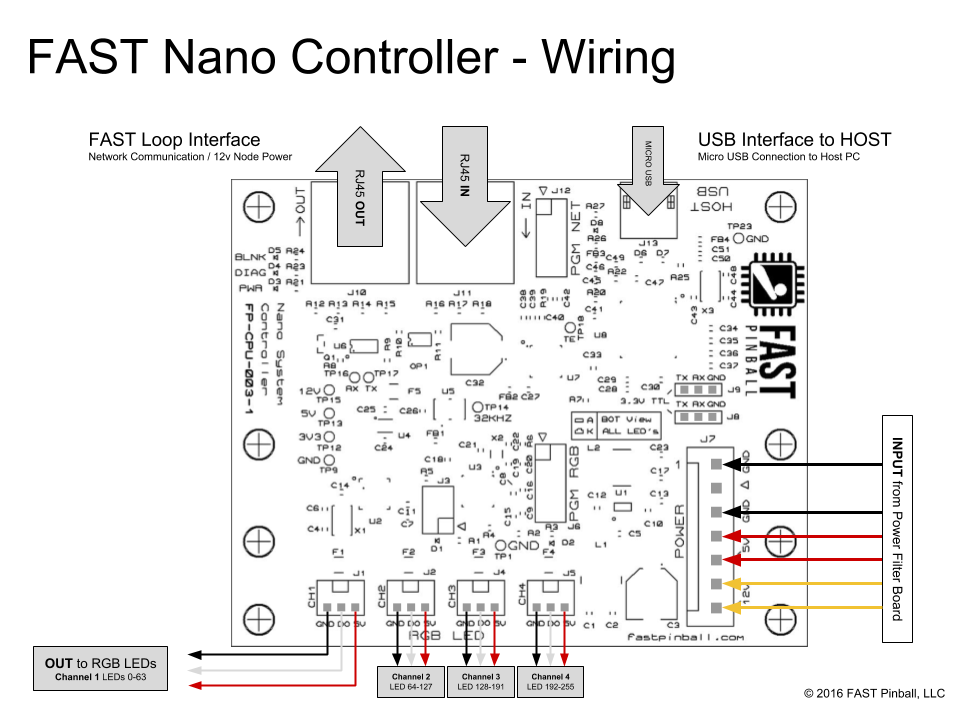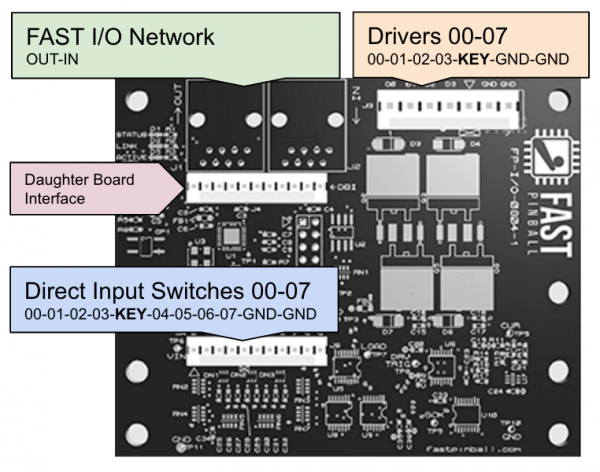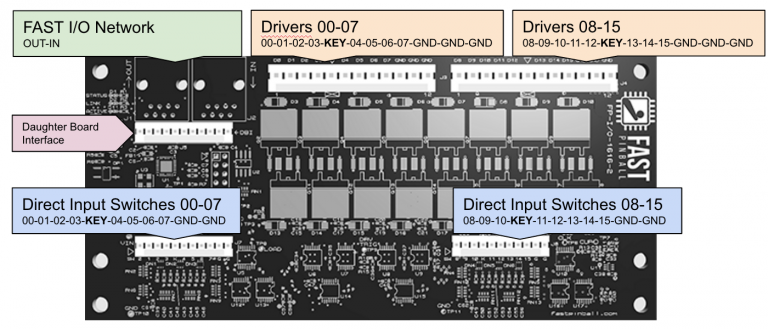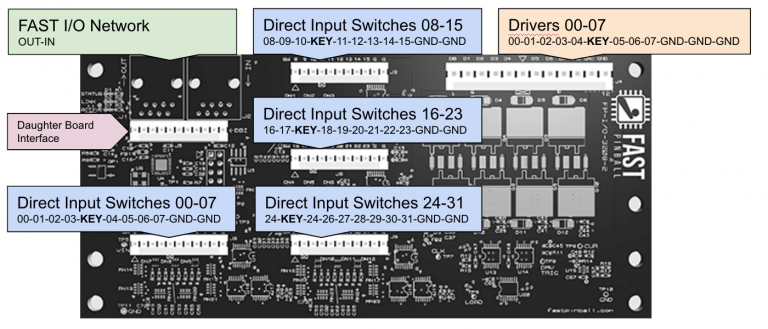Difference between revisions of "Fast"
(Created page with "= Architecture = Fast Pinball offers a [http://fastpinball.com/platform/hardware pinball control systems] which consists of a controller and multiple node boards. There is cur...") |
m (→Drivers) |
||
| (3 intermediate revisions by the same user not shown) | |||
| Line 1: | Line 1: | ||
= Architecture = | = Architecture = | ||
| − | Fast Pinball offers a [http://fastpinball.com/platform/hardware pinball control systems] which consists of a controller and multiple node boards. There is currently only one controller available. It is called the [http://fastpinball.com/platform/hardware/controllers/fast-nano-controller Nano] | + | Fast Pinball offers a [http://fastpinball.com/platform/hardware pinball control systems] which consists of a controller and multiple node boards. There is currently only one controller available. It is called the [http://fastpinball.com/platform/hardware/controllers/fast-nano-controller Nano]. It supports a chain of node boards and 128 serial RGB LEDs. |
The following node boards are available: | The following node boards are available: | ||
| − | [http://fastpinball.com/platform/hardware/io/fast-io-3208 Fast IO 3208] - 32 inputs and 8 drivers | + | * [http://fastpinball.com/platform/hardware/io/fast-io-3208 Fast IO 3208] - 32 inputs and 8 drivers |
| − | [http://fastpinball.com/platform/hardware/io/fast-io-1616 Fast IO 1616] - 16 inputs and 16 drivers | + | * [http://fastpinball.com/platform/hardware/io/fast-io-1616 Fast IO 1616] - 16 inputs and 16 drivers |
| − | [http://fastpinball.com/platform/hardware/io/fast-io-0804 Fast IO 0804] - 8 inputs and 4 drivers | + | * [http://fastpinball.com/platform/hardware/io/fast-io-0804 Fast IO 0804] - 8 inputs and 4 drivers |
Most machines use a 3208 for the lower playfield. The 0804 is often used as cabinet node. Upper playfield configurations differ. | Most machines use a 3208 for the lower playfield. The 0804 is often used as cabinet node. Upper playfield configurations differ. | ||
Node boards are connected in a Ring using RJ45 cables. Nano connects to the first board (ID 0). First board to the second and so on. Last board connects back to the Nano. | Node boards are connected in a Ring using RJ45 cables. Nano connects to the first board (ID 0). First board to the second and so on. Last board connects back to the Nano. | ||
| + | |||
| + | == Controller == | ||
| + | |||
| + | [[File:FAST_Nano.png]] | ||
| + | [[File:FAST_Nano_Wiring.png]] | ||
| + | |||
| + | == Node boards == | ||
| + | |||
| + | [[File:FAST_0804.png]] | ||
| + | [[File:FAST_1616.png]] | ||
| + | [[File:FAST_3208.png]] | ||
= Switches = | = Switches = | ||
| − | Switches are organized in banks of 8. They | + | Switches are organized in banks of 8. They pull the voltage to 12V using an internal pull up. If you connect an switch input to ground the switch will be considered closed. You can connect normal pinball switches and optos directly to inputs. |
| + | See [http://docs.missionpinball.org/en/latest/hardware/fast/switches.html How to configure switches in FAST with MPF]. | ||
= Drivers = | = Drivers = | ||
Boards contain drivers in banks of 8 (except the 0804 which contains a bank of only 4 drivers). All drivers pull to ground. Connect your mechs to high voltage (HV) and connect the other side to a driver. When the driver is activated the current will flow. | Boards contain drivers in banks of 8 (except the 0804 which contains a bank of only 4 drivers). All drivers pull to ground. Connect your mechs to high voltage (HV) and connect the other side to a driver. When the driver is activated the current will flow. | ||
| + | See [http://docs.missionpinball.org/en/latest/hardware/fast/drivers.html How to configure switches in FAST with MPF]. | ||
= Flipper rules = | = Flipper rules = | ||
Fast supports only node local rules which means that switch and driver have to be on the same board. | Fast supports only node local rules which means that switch and driver have to be on the same board. | ||
For instance if the switch of a popbumper is connected to switch 2 on node board 1 then the coil also has to be connected to an output on node board 1. The first 8 switches on the first board (ID 0) are special since those are local to every node board. E.g. you can connect your flipper buttons to inputs 0 and 1 on the first node board (as cabinet node board) and connect the drivers to node 2 below the playfield. | For instance if the switch of a popbumper is connected to switch 2 on node board 1 then the coil also has to be connected to an output on node board 1. The first 8 switches on the first board (ID 0) are special since those are local to every node board. E.g. you can connect your flipper buttons to inputs 0 and 1 on the first node board (as cabinet node board) and connect the drivers to node 2 below the playfield. | ||
| + | See [http://docs.missionpinball.org/en/latest/hardware/fast/hw_rules.html How to configure hardware rules with MPF and FAST]. | ||
= DMDs = | = DMDs = | ||
Fast offers a standalone RGB DMD display which interfaces via USB. | Fast offers a standalone RGB DMD display which interfaces via USB. | ||
| + | See [http://docs.missionpinball.org/en/latest/hardware/fast/rgb_dmd.html How to configure FAST DMD with MPF]. | ||
= Special hardware = | = Special hardware = | ||
All Fast node board support one daughter board. | All Fast node board support one daughter board. | ||
Currently there is a servo daughter board for six servos. | Currently there is a servo daughter board for six servos. | ||
Latest revision as of 15:00, 7 July 2018
Contents
Architecture
Fast Pinball offers a pinball control systems which consists of a controller and multiple node boards. There is currently only one controller available. It is called the Nano. It supports a chain of node boards and 128 serial RGB LEDs.
The following node boards are available:
- Fast IO 3208 - 32 inputs and 8 drivers
- Fast IO 1616 - 16 inputs and 16 drivers
- Fast IO 0804 - 8 inputs and 4 drivers
Most machines use a 3208 for the lower playfield. The 0804 is often used as cabinet node. Upper playfield configurations differ.
Node boards are connected in a Ring using RJ45 cables. Nano connects to the first board (ID 0). First board to the second and so on. Last board connects back to the Nano.
Controller
Node boards
Switches
Switches are organized in banks of 8. They pull the voltage to 12V using an internal pull up. If you connect an switch input to ground the switch will be considered closed. You can connect normal pinball switches and optos directly to inputs. See How to configure switches in FAST with MPF.
Drivers
Boards contain drivers in banks of 8 (except the 0804 which contains a bank of only 4 drivers). All drivers pull to ground. Connect your mechs to high voltage (HV) and connect the other side to a driver. When the driver is activated the current will flow. See How to configure switches in FAST with MPF.
Flipper rules
Fast supports only node local rules which means that switch and driver have to be on the same board. For instance if the switch of a popbumper is connected to switch 2 on node board 1 then the coil also has to be connected to an output on node board 1. The first 8 switches on the first board (ID 0) are special since those are local to every node board. E.g. you can connect your flipper buttons to inputs 0 and 1 on the first node board (as cabinet node board) and connect the drivers to node 2 below the playfield. See How to configure hardware rules with MPF and FAST.
DMDs
Fast offers a standalone RGB DMD display which interfaces via USB. See How to configure FAST DMD with MPF.
Special hardware
All Fast node board support one daughter board. Currently there is a servo daughter board for six servos.

